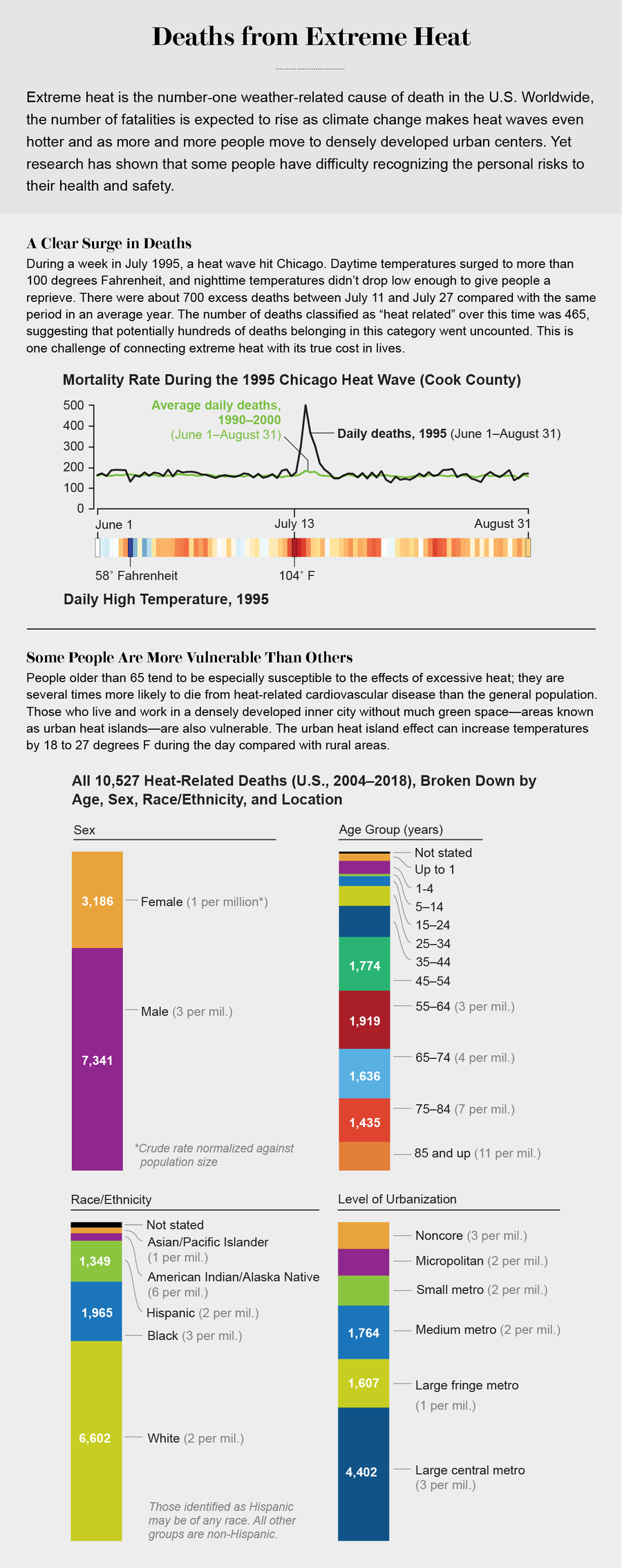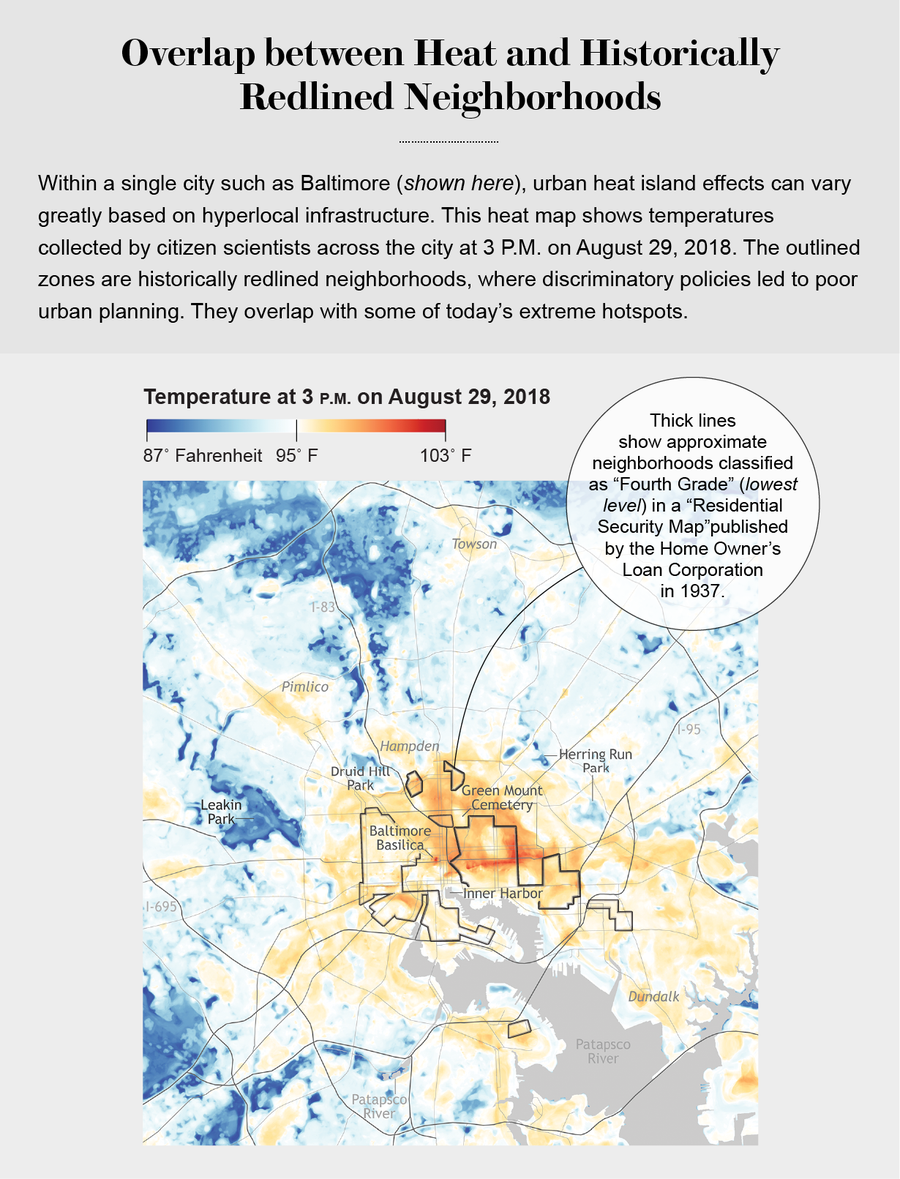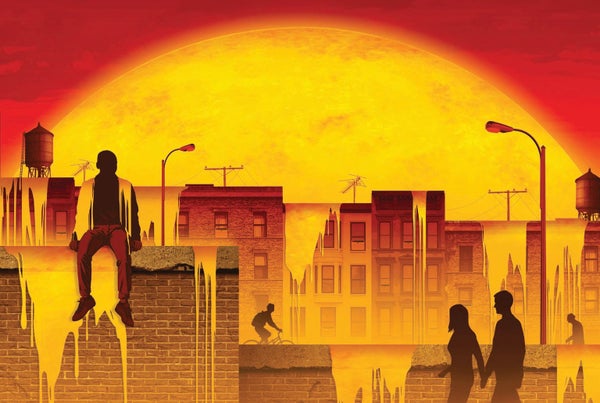On June 25, 2022, Esteban Chavez, Jr., started his day like any other, working his route in Pasadena, Calif., as a driver for UPS. But the city was in the middle of an intense heat wave, and by midafternoon the temperature was higher than 90 degrees Fahrenheit. After completing his last delivery of the day, Chavez collapsed off his seat in the cab of the truck. He went unnoticed for 20 minutes before the homeowner at his delivery location saw him and sought medical assistance. Chavez's family said he died from heatstroke as a result of heat exhaustion. He was 24 years old.
Chavez didn't seem like someone at risk for the health effects of extreme heat. But such unfortunate deaths are increasingly common. The number of heat-related illnesses and fatalities in the U.S. has been going up since the 1980s—a direct result of the rise in Earth's temperatures. Approximately 1,300 people die in the U.S. every year from exposure to extreme heat, according to the Environmental Protection Agency, and that figure that will almost certainly increase with the accelerating effects of climate change. This phenomenon is, of course, not exclusive to the U.S.; a study published in 2021 by the Lancet reports that 356,000 people in nine countries—about half the population of Vermont—died from illnesses related to extreme heat in 2019.
Exposure to extreme heat can damage the central nervous system, the brain and other vital organs, and the effects can set in with terrifying speed, resulting in heat exhaustion, heat cramps or heatstroke. It also exacerbates existing medical conditions such as hypertension and heart disease and is especially perilous for people who suffer from chronic diseases. The older population is at high risk, and children, who may not be able to regulate their body temperatures as effectively as adults in extreme conditions, are also vulnerable. But people of all ages can be endangered. Studies show that outdoor workers regardless of age are most likely to experience the consequences of extreme heat exposure.
On supporting science journalism
If you're enjoying this article, consider supporting our award-winning journalism by subscribing. By purchasing a subscription you are helping to ensure the future of impactful stories about the discoveries and ideas shaping our world today.
Extreme heat is the number-one weather-related cause of death in the U.S., and it kills more people most years than hurricanes, floods and tornadoes combined. Yet research shows that compared with their thinking about dramatic events such as storm surges and wildfires, people tend to feel more uncertain about what to do under the threat of extreme heat and don't perceive as much personal risk. This mismatch between the reality of the danger and the actions people take to protect themselves extends beyond individual perception to the policy level. Heat risks to human health are not often prioritized in climate mitigation and adaptation plans—if they are factored in at all.
Discriminatory Policies and Urban Hotspots
Between 1880, when precise recordkeeping began, and 1980, average temperatures worldwide rose by about 0.13 degree F every 10 years. Since 1981 the rate of increase has more than doubled, and for the past 40 years global annual temperatures have increased by 0.32 degree F per decade. Although the pace of the increase might seem relatively slow, it signals a dramatic shift, and the cumulative effects on the planet are huge. The 10 hottest years on record have occurred since 2010. The summer of 2022 was the hottest in known history for segments of the U.S. Temperatures soared to 127 degrees F in Death Valley, Calif., where extremes are expected. But record highs were also reached across the U.S. in cities that aren't accustomed to severe heat, such as Bonners Ferry, Idaho (108 degrees F), and Omak, Wash. (117 degrees F).

Credit: Jen Christiansen; Sources: EPA’s Climate Change Indicators in the United States (Chicago heat-wave reference, with data from CDC and NOAA); “Heat-Related Deaths, United States, 2004–2018,” by Ambarish Vaidyanathan et al., in Centers for Disease Control and Prevention: Morbidity and Mortality Weekly Report, Vol. 69. No. 24; June 19, 2020 (heat-related death data)
Extreme heat is a danger to all segments of society, but people in dense urban environments suffer the most severely. The connection between urbanization and heat risks will become more urgent as more people around the world move to urban areas. According to the United Nations Population Division, 68 percent of the planet's population will live in urban areas by 2050, up from 55 percent in 2018. The rate of global urbanization, however, hides differences across nations: 82 percent of people in North America already live in urban environments compared with 65 percent in China and 43 percent in Africa. In the U.S., the rate of urbanization (people moving from rural areas to cities) increased from 50 percent in the 1950s to 83 percent in 2020. This rapid growth on top of environmental changes compounds stressors on human health, infrastructure, socioeconomic systems, and essential resources such as energy and water.
Urban centers tend to have a high density of buildings, paved roads and parking lots—all of which absorb and retain heat. Green spaces such as parks and golf courses, in contrast, reduce heat levels in neighborhoods by lowering surface and air temperatures through evapotranspiration. Mature trees and other natural features provide shade, deflect the sun's radiation and release moisture into the atmosphere. As heat waves become more frequent and intense, cities are experiencing higher nighttime and mean temperatures compared with areas that have a lot of green space. This is commonly called the heat island effect.
Within these heat islands are especially hot hotspots, or intraurban heat islands, which tend to have the least green space. Recent studies have shown that “extreme heat exposure is highly unequal and severely impacts the urban poor,” as stated in a 2021 paper in the Proceedings of the National Academy of Sciences USA. The link between vulnerable populations and the lack of green space in the neighborhoods where they live results from cascading issues; among them are policies designed to restrict the upward mobility of certain groups, such as redlining practices that date back to the 1930s.
The term “redlining” denotes the assignment of grades to residential areas based on their racial composition; the lower-graded neighborhoods were less likely to receive investments, and people living in them had a harder time obtaining loans. The redlining practice grew from President Franklin D. Roosevelt's federally funded New Deal, which enforced segregation practices. The Federal Housing Administration, for instance, refused to insure the homes of Black and other nonwhite families or homes owned by white people that were considered too close to Black neighborhoods. Local governments that practiced “benign neglect” created isolated zones devoid of resources and opportunities.
Today's hotspot communities often suffer from the long-term effects of these discriminatory urban-planning policies, including inadequate access to parks and green spaces. And for people who live in these areas, central air-conditioning may not be an affordable solution, if it's even an available option. Many older buildings have never been retrofitted to accommodate central air—a common situation in the inner city in places such as New York, Detroit and Baltimore—leaving people reliant on smaller, portable window units and fans.
Regardless of the cooling technology used, low-income households in America spend 8.1 percent of their income on energy costs compared with 2.3 percent for non-low-income households, according to a 2020 report from the American Council for an Energy Efficient Economy. The ability to reduce energy costs (by updating house insulation and switching to efficient electric appliances, for instance) is largely out of the control of renters and may be unaffordable for lower-income homeowners. Thus, the most vulnerable people in the hottest hot zones must face decisions that pit the high energy cost of staying cool and safe against providing for other necessities of life. As a result, they may be more at risk for heat-related illness and death because of both overexposure to high temperatures where they live and the lack of resources to mitigate the effects of that heat.
Better Risk Assessment
In the past the heat island effect had little connection to global climate trends, but recent research findings suggest that, on average, urban heat island warming will be equivalent to about half the warming caused by greenhouse gas emissions by the year 2050. In other words, cities get a double punch: both climate change and urban development that swaps green space for pavement are warming metropolitan areas, influencing the chemistry of the atmosphere and intensifying urban air pollution. Currently global temperatures are predicted to increase by 3.8 to 6.3 degrees F by 2100—resulting in intolerable heat thresholds for urban environments.
Given the scope of the problem, how can we lessen the negative effects of extreme heat events on historically vulnerable urban communities? At Howard University's NOAA Cooperative Science Center for Atmospheric Sciences and Meteorology, my colleagues and I are interested in understanding how people process risk associated with extreme heat and respond to heat advisories. As scholars from disciplines spanning atmospheric sciences, communications, computer science and sociology, we want to learn how to inform better decision-making in communities so we can help them make useful and realistic plans for both the short and the long term.

Credit: NOAA Climate.gov (map); Portland State SUPR Lab (data); Redlined zones added by Jen Christiansen using Residential Security Map of Baltimore Md., prepared by Home Owner’s Loan Corporation Division of Research & Statistics, with cooperation of the Appraisal Department, May 29, 1937, courtesy Baltimore City Sheet Maps Collection, The Sheridan Libraries, Johns Hopkins University (reference for redlined zones)
Our current work is taking place in Baltimore, which ranks among the U.S. cities with the most intense urban heat island effects. A 2020 study led by Jeremy Hoffman of the Center for Environmental Studies at Virginia Commonwealth University showed that in Baltimore neighborhoods where a history of redlining practices has blocked investment, summer temperatures are nearly six degrees F hotter than the citywide average. The research project uses an integrative citizen science approach, giving us an excellent opportunity to learn from members of communities experiencing some of the worst effects. To assess people's responses to weather forecasts and heat events in Baltimore, we developed an app that merges weather data, risk communication and behavioral health information to push messages to study participants. The app also collects behavioral responses to extreme heat alerts.
Some early research activities involved talking with city residents to discern how they perceive and respond to extreme heat events. As part of this, we asked about their awareness of warnings and potential impacts of exposure. We conducted interaction-based interviews with focus groups, which allowed us to observe conversations among participants and hear both individual and collective responses.
When asked about their level of awareness concerning heat advisories, many focus group participants appeared to have general knowledge about the topic: they reported being aware of heat advisory warnings, and the majority said they modified their behavior in response to those warnings by trying to drink more water and delaying physical activities until later in the day. Most people, however, were unsure of the meanings behind the different threat levels, which are typically presented as part of a weather forecast, and were confused about how to interpret them. For instance, some people were not aware of the difference between a heat “watch” (be prepared) and a heat “warning” (take action now to protect yourself).
We also found that people have very limited knowledge of the “heat index”—a measure that factors in relative humidity to estimate how a given day's temperature actually feels to the human body. This data point is superior to temperature alone for alerting the public to especially dangerous types of heat. It became clear to us that people would additionally benefit from greater awareness of the effects of climate change in general, so they would know to expect heat-related problems to get worse over time.
One of our essential findings is that knowledge of general heat risks does not necessarily lead to an accurate perception of one's own risk. Several study participants indicated that they were aware of the different ways people could protect themselves from heat, but this knowledge did not translate into their personally taking protective actions. Some participants said they do not believe they are at direct risk. As one person put it: “To me, it being 90 degrees did not really say anything [because I'm] from the Caribbean. Like, sometimes it is 100, 105.” Interestingly, our study's older participants, considered by health professionals as high risk for the dangerous effects of heat exposure, did not think of themselves as especially at risk.
This summer the Howard University team is distributing air monitors, Internet hotspots and cell phones (for those who do not currently own one) to community members who elected to participate in the study. These tools will collect data at no cost to the participants, who will receive $200 for taking part in the project over three months. The real-time indoor weather data will enable us to monitor heat exposure. As temperatures rise, the study participants will be alerted to the onset of an extreme heat event or heat wave via an app or, when appropriate, phone calls and e-mail. They will be reminded to use the app to access information on the heat index, as well as the risk of extreme heat exposure and suggested protective actions. The types of help and resources recommended by the app will be personalized for the study participants based on their individual risk factors.
Subsequent alerts will be tailored to the needs of the target population, with particular attention to message framing. This approach will include a clear and easy-to-digest explanation of the levels of risk uncertainty to help people understand why they should take action even if some parts of the forecast don't come to fruition. We think people need more information to best manage their expectations, not just to make good decisions. It's important for them to do so because the National Weather Service is increasingly incorporating the language and visuals of uncertainty into public discussions that reflect the estimates in forecast models. After data have been collected, study participants will be surveyed for insights on how the messaging influenced their self-protective actions and help-seeking behaviors.
Although there is no fail-safe approach to addressing the risks associated with high heat exposure, talking more about what's at stake is a good start. The potential dangers of excessive heat extend beyond physiological health to facets of life such as increased rates of domestic violence and crime. There are economic consequences, too: according to the Atlantic Council, the U.S. could lose some $100 billion annually because of extreme heat effects.
The hope is that increased awareness of the gap between risk and protective actions will force policy makers to take these issues more seriously and factor them into climate-preparedness plans. Opening cooling centers during a heat wave might not be enough to prevent unnecessary deaths if people don't think they need to go. More effective communication is one critical tool for reducing the harmful consequences of extreme heat on human health.

